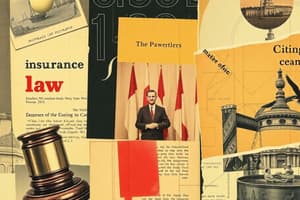Podcast
Questions and Answers
Which of the following best describes an open-perils insurance policy?
Which of the following best describes an open-perils insurance policy?
- It covers only the perils specifically named in the policy.
- It only covers direct losses, not indirect losses.
- It covers all losses except those specifically excluded. (correct)
- It is less expensive than a named-peril policy.
Declarations in an insurance policy specify the major promises of the insurer.
Declarations in an insurance policy specify the major promises of the insurer.
False (B)
What is the primary purpose of the 'insuring agreement' section in an insurance policy?
What is the primary purpose of the 'insuring agreement' section in an insurance policy?
Summarizes the major promises of the insurer
An amount subtracted from the total loss payment that the insured must pay is known as the ______.
An amount subtracted from the total loss payment that the insured must pay is known as the ______.
Match each type of insurance clause with its description:
Match each type of insurance clause with its description:
Which of the following is NOT a typical reason for exclusions in an insurance policy?
Which of the following is NOT a typical reason for exclusions in an insurance policy?
A 'moral hazard' in insurance refers to the increased likelihood of losses due to extraordinary external events.
A 'moral hazard' in insurance refers to the increased likelihood of losses due to extraordinary external events.
What is the purpose of requiring 'proof of loss' as a condition for insurance coverage?
What is the purpose of requiring 'proof of loss' as a condition for insurance coverage?
In an insurance context, demutualization refers to a mutual insurer converting to a ______ company.
In an insurance context, demutualization refers to a mutual insurer converting to a ______ company.
Match the following terms to their correct definitions in the context of insurance:
Match the following terms to their correct definitions in the context of insurance:
Which of the following best describes the role of a 'captive insurer'?
Which of the following best describes the role of a 'captive insurer'?
Lloyd's of London is an insurance company that directly insures individuals and businesses.
Lloyd's of London is an insurance company that directly insures individuals and businesses.
What distinguishes an independent insurance agent from an exclusive agent?
What distinguishes an independent insurance agent from an exclusive agent?
The process of selecting, classifying, and pricing applicants for insurance is known as ______.
The process of selecting, classifying, and pricing applicants for insurance is known as ______.
Match the following types of claims adjustors to their descriptions:
Match the following types of claims adjustors to their descriptions:
What is the primary purpose of reinsurance?
What is the primary purpose of reinsurance?
In reinsurance, the 'ceding company' is the insurer that accepts the insurance from another insurer.
In reinsurance, the 'ceding company' is the insurer that accepts the insurance from another insurer.
How do investments affect insurance premiums?
How do investments affect insurance premiums?
The cyclical pattern of underwriting stringency, premium levels, and profitability in the insurance industry is known as the ______ cycle.
The cyclical pattern of underwriting stringency, premium levels, and profitability in the insurance industry is known as the ______ cycle.
Match financial ratios with their descriptions in the context of insurance companies:
Match financial ratios with their descriptions in the context of insurance companies:
Flashcards
Insurance Declarations
Insurance Declarations
The page that provides information about the insured property or activity.
Insuring agreement
Insuring agreement
Summarizes the insurer's major promises.
Named-Peril Policy
Named-Peril Policy
Covers only perils specifically named in the policy.
Open-Perils Policy
Open-Perils Policy
Signup and view all the flashcards
Exclusion
Exclusion
Signup and view all the flashcards
Reasons for Exclusions
Reasons for Exclusions
Signup and view all the flashcards
Conditions
Conditions
Signup and view all the flashcards
Definitions of the "insured"
Definitions of the "insured"
Signup and view all the flashcards
Actual Cash Value (ACV)
Actual Cash Value (ACV)
Signup and view all the flashcards
Coinsurance Clause
Coinsurance Clause
Signup and view all the flashcards
Pro Rata (Property)
Pro Rata (Property)
Signup and view all the flashcards
Primary and Excess
Primary and Excess
Signup and view all the flashcards
Endorsement
Endorsement
Signup and view all the flashcards
Risk Avoidance
Risk Avoidance
Signup and view all the flashcards
Loss Control
Loss Control
Signup and view all the flashcards
Risk Retention
Risk Retention
Signup and view all the flashcards
Self-Insurance
Self-Insurance
Signup and view all the flashcards
Risk Transfer
Risk Transfer
Signup and view all the flashcards
Stock Insurer
Stock Insurer
Signup and view all the flashcards
Mutual Insurer
Mutual Insurer
Signup and view all the flashcards
Study Notes
Basic Parts of an Insurance Contract
- Declarations are statements providing information about the insured property or activity
- They are specific to the insured
- Includes the insured's name, property location, coverage period, insurance amount, premium, and deductible
- The insuring agreement summarizes the insurer's major promises and the type of insurance agreement
Property Insurance Forms
- Named-peril policies cover only perils specifically named in the policy
- Less expensive than open-peril policies
- If a peril is not explicitly listed, it is not covered
- Open-peril policies ("all-risk") cover all losses except those specifically excluded
- The insurance tells you which perils are not covered
- Covers every peril except exclusions, even unexpected losses
Exclusions
- Exclusions are a list of things not covered
- Excluded perils include flood and earthquake
- Excluded losses include direct or indirect losses
- Excluded property means coverage excludes specific items, like pets
- Excluded locations means Coverage applies only in certain locations, such as within the USA (excluding Mexico)
Reasons for Exclusions
- Some perils are not commercially insurable if they don't meet insurable interest requirements
- Insurance for extraordinary hazards from a company is excludable
- Tobacco companies can get insurance but cannot get product liability insurance due to high risk
- Certain exclusions can be removed for added cost
- Coverage is provided by other contracts like a homeowner's policy covering the content of a house but not vehicles
- Moral hazard concerns are limited due to fraud possibilities
- Cash coverage is limited to amounts such as $2000
- Coverage isn't needed by typical insureds, so insurance excludes less common needs for everyone else
Conditions for Coverage
- Insureds must follow some provisions to obtain coverage
- Notification of a loss is required in a timely manner (up to 30 days after the event)
- Proof of loss is required for claims
- Cooperation with the insurer is required
Definitions in Insurance Contracts
- Definitions provide intended meaning of terms for insureds and courts
- Insurers should precisely define terms and placement of the definition should be at the beginning of the policy
- "Insured" definitions specify who receives protection, located on the declarations page
- The named insured is the person named on the declarations page and a policy may cover other parties, even unnamed ones
- Examples are someone else driving an insured's car, or employees in a company
Basic of Recovery
- ACV is the Actual Cash Value and Replacement Cost
- ACV accounts for depreciation (example is 10 years for a sofa)
- Replacement cost doesn't deduct depreciation (example is a destroyed roof)
Clauses Limiting Amounts Payable
- Dollar limits in property insurance apply to the aggregate limit of staff coverage
- Specific limits are like paying no more than $500 for any plant, tree, etc
- An aggregate limit is when personal property coverage has say a $75,00 limit and is applicable for all staff
- Liability insurance limits apply when the insured is sued
- Per occurrence limit is applicable per event
- If a fire injures 6 customers, a company's $5,000,000 per occurrence limit is the maximum payout
- Aggregate limits apply to all losses for the year
- A $25,000,000 aggregate limit is the maximum payout for all losses in the year
Deductibles
- A deductible is an amount subtracted from the total loss payment
- Deductibles reduce premiums, eliminate small claims, and reduce moral/morale hazards
- A straight deductible is paid by the insured for every loss
- An aggregate deductible accumulates all losses during a period to satisfy the deductible
- Health insurance may require paying the deductible once per year
Coinsurance Clause
- This clause incentivizes the insured to buy coverage for at least 80% (or a fixed percentage) of the building's value
- Common in property insurance, it encourages insuring property to a stated percentage of its insurable value
- It promotes equity in rating
- If coinsurance isn't met, the insured shares in the loss
Recovery Formula
𝑖𝑛𝑠𝑢𝑟𝑎𝑛𝑐𝑒 𝑐𝑎𝑟𝑟𝑖𝑒𝑑
(𝑐𝑜𝑖𝑛𝑠𝑢𝑟𝑎𝑛𝑐𝑒 %)∗ 𝑝𝑟𝑜𝑝𝑒𝑟𝑡𝑦 𝑣𝑎𝑙𝑢𝑒 𝑎𝑡 𝑡𝑖𝑚𝑒 𝑜𝑓 𝑡ℎ𝑒 𝑙𝑜𝑠𝑠
- 𝑙𝑜𝑠𝑠 − 𝑑𝑒𝑑𝑢𝑐𝑡𝑖𝑏𝑙𝑒
- This formula is used if you don't meet the coinsurance requirements
- "Did" refers to how much insurance you did buy
- "Should" refers to how much you should have bought to meet coinsurance requirements (for example, $80,000)
- Example: Policy limit 200,000, deductible 0, coinsurance 80%, loss 80,000, property value at time of loss 500,000
- Recovery formula is (200,000/(.8*500,000))*80,000 = 40,000
Other-Insurance Clauses
- These prevent profiting from multiple insurance coverage, in violation of indemnity principles
- Pro rata(property): Each insurer's share is based on its proportion of the total insurance
- They will share the loss but will pay up to the value
- Primary and excess: The primary insurer pays first and the excess insurer pays after primary limits are exhausted
Coverage Example
- A property worth $500,000 has three insurance policies.
- Company A policy limit: $300,000
- Company B policy limit: $100,000
- Company C policy limit: $100,000
- If the loss is $100,000, they divide each policy limit by the total coverage worth
- The ratios are 300,000 / 500,000 and 100,000 / 500,000
Primary and Excess Insurance
- Coverage under two liability policies occurs as follows
- Company A is primary at 100,000
- Company B is excess at 75,000 limit
- if the the covered loss of 150,000 happens
- Company A pays 100,000
- Company B pays 50,000
Insurance Decision Making
- Decisions include coverages, deductibles, limits, policy language, and choice of insurer
- It is important to analyze which insurer is best considering service quality, customer service and financial strength
- One must do this for every policy as a business
- Manuscript policies are adjusted to meet specific needs unlike standard policies
- An endorsement is an add-on or amendment to the standard policy
- A USA-only driver can buy coverage for driving in Mexico
Endorsements or Riders
- Endorsements/riders add to, delete from, or modify the provisions of the original contract
- Two types are Property-Casualty or Life-Health
- Endorsements/riders take precedence over conflicting policy provisions
Selecting Risk Management Techniques
- Implementing risk management techniques involves selectin and implementation, following these steps
- Avoid risks if possible and desirable
- Implement appropriate loss control measures to reduce frequency and severity of losses
- Select optimal mix of retention and transfer (how much to keep and/or transfer)
- Steps 2 and 3 are not strictly sequential/independent
Avoidance
- Risk elimination can occur entirely
- For example, moving from Florida to Kansas to avoid hurricanes
- Risk elimination not always desired, as risk management isn't always about minimizing risk
- One may need to give up opportunities
- Risk elimination may create other risks like moving away from hurricanes, only to be hit by tornados
Loss Control
- Decisions based on cost/benefit analysis
- Consider all costs and benefits
- Present value analysis is required
- Sometimes the cost is higher than the benefit
Retention Versus Transfer
- Retention means high frequency/low severity
- Transfer means low frequency/high severity
Combining Retention and Transfer
- Insurance is combined with a deductible
- It is important to consider whether losses within deductible are affordable and if premium reductions are sufficient
Self Insurance
- Self-insurance means acting like an insurer
- It involves predicting losses and setting aside money to pay them
- An important factor is consideration of having a sufficient number of independent exposures
- Do we have 10k workers where we self insure?
- One must have adequate data to calculate expected losses and adequate administrative ability
Third Party Administrator ("TPA") Option
- Involves finding someone with expertise in a work comp system charging a fee
- Ask if if the firm can handle losses
- Stop-loss insurance can be purchased for very large losses (individuals and/or aggregate)
- Specific stop-loss covers each individual loss, while aggregate stop-loss limits the sum of all losses
Risk Management Implementation
- Implementation and monitoring involves a risk management organizational structure
- Traditional vs ERM (Enterprise Risk Management)
- A risk management policy statement documents risk management within the company
- Active cooperation should occur across the firm and continuous review should be undertaken
- A risk management program can reduce a firm's costs
- It minimizes cost to potential losses
- It minimizes cost of unreimbursed losses
- It minimizes outlays to reduce risk
- It minimizes oppurtunity cost of forgone activities
The Insurance Industry
- The financial services industry consists of
- Commercial banks
- Savings and loans institutions
- Credit unions
- Life and health insurers
- Wealth management
- Major trends include consolidation due to mergers and acquisitions
- And convergence due to existing financial institutions selling a variety of financial products
- This creates more 2-in-1 type banks and one stop stops for financial services
Types of Private Insurers
- The Life and Health insurance sector of the US insurance market is in the range of 1600
- 800+ focused on life and 800+ focused on health
- These insurers sell life and health products, annuities, mutual funds, pension plans and related financial products
- The Property and casualty insurers sector is in the range of 2500
- These insurers sell property and casualty insurance and related lines
- Annual premiums total $1.1 trillion, with assets totaling $5.5 trillion
- The insurance industry represents ~2.7% of GDP and employs ~3 million people
Types of Property-Liability Insurers
- These insurers may be classified by their organizational form
- A stock insurer is a corporation owned by stockholders
- Objective is to earn profit
- Stockholders elect a board of directors and may pay dividends
- Insurers cannot issue an assessable policy where stockholders pay extra to cover past losses
- Ex: AIG
- A mutual insurer is a nonprofit corporation owned by the policyowners
- Policyowners elect a board of directors, who appoint executives, and may pay dividends
- Types of Mutual Insurers:
- Advance Premium Mutual: Works like a stock company charging a premium
- They may not come back and ask for more money to pay for losses
- Assessment Mutual: (not common) can charge more if losses exceed premiums in claim
Stock and Mutual Insurers
- Stock insurers typically have more pressure to perform compared to mutual insurers
- Mutual companies do not have much discipline with management
- if policyholders don't like how the company is run they can just switch
- Stock insurers pay taxes while mutual insurers do not
- Demutualization stops the company from being mutual and turning it into a stock company
- Access to capital is improved by being able to issue new stock
- The company improves its ability to grow and acquire through stock swaps
- Ability to use stock and stock options to motive management
- The CEO gets stock if it is good for the company
Lloyds of London
- Lloyds of London is not an insurer, but a marketplace where insurers underwrite insurance in syndicates
- 80+ syndicates underwrite there
- They specialize in large, complex P&C risks
- People access them through Lloyds brokers, who operate as part of the surplus lines market in the U.S.
Reciprocal Insurers
- They are an unincorporated mutual (not in the exam)
- Similar to an advance premium mutual
- The legal distinction is how they are legally organized
Captive Insurers
- These Insurers are owned by a parent firm(s) to insure the loss exposures of the parent(s)
- ~6000 captive insurers exist worldwide
- Ex: Arturo Inc starts an insurance company called "Arturo insurance firm" to ensure losses of Arturo Inc.
- Self insurance method
- Usually located in the bermuda, caymen islanders, vermont
Captive Insurer Incentives Example
- A company with 100 retail locations can give each location the incentive to control losses
- Locations with higher losses may pay higher premiums the parent company
P&C Insurance Marketing System
- (Independent) agents legally represent the insurer and have the authority to act on the insurer's behalf
- P&C agents have binding authority
- What the contractor said the insurer bound (approved)
- Paid primarily by commissions, dominating personal lines insurance
- Independent agents do not contract with one insurer but have a contract with multiple insurers to sell on their behalf
- They also represent numerous insurers
Exclusive Agents
- Exclusive agents only represent one insurer and are compensated by commissions
- Brokers legally represent the corporate client, not the insurance companies (insurers)
- Brokers help decide what insurance you need, send quotes to underwriters and give clients pros/cons
- A broker may compare and assist the client in device which insurer to use, Middle man(intermediary between client and underwriter)
- A broker legally represents the insured
- Brokers have no binding authority and cannot legally bind an insurance company
- They are paid by commissions (from insurers) and fees (from clients)
- They dominate commercial insurance lines
- Direct response comes directly from the insurer
- Sells directly to consumer through television or some other media (eg. GEICO)
Functions and Organizations of Insurers
- Rate making is the pricing of insurance (macro pricing) with the goal total premiums charged are adequate to pay all claims/expenses
- Key people setting rates are actuaries, where A rate is the price per unit of insurance
- An example exposure unit is $100 of property value, meaning if you buy $100 of coverage, they price by multiply 100*1000)
- The pure premium is the needed rate to pay losses and loss adjustment expenses
- Loading is the amount that must be added to the pure premium for other expenses plus margin for contingencies
- The gross premium is (pure premium + loading)
Gross Premium ("GP") Formula
𝐺𝑃 = 𝑃𝑃/(1 − 𝐿𝑃)
- Where GP = Gross premium, PP = Pure premium, and LP = Loading percentage
- Therefore to find the premium when expected loss is $1000 and insurer wants a 20% loading
- The calculated premium is $1000/(1-.2) = $1,250
Underwriting
- Underwriting is the process of selecting, classifying, and pricing applicants for insurance
- One must get the guidance from actuaries and look at the particular business applying when deciding the price
- The goal is to produce a profitable book of business
- Insurers measure how the book is doing
- Different insurers have different underwriting policies including
- Acceptable classes of business, setting what amounts of insurance that can be written
- The line underwriters make daily based on the company's underwriting policies
- Basic Underwriting principles (3):
- Attain an underwriting profit on book of business, selecting prospective insureds according to the company’s underwriting standards
- Maintain equity among the policyholders, Pricing according to the insured's risks
The Underwriting Process
- Underwriting Involves field underwriting (done by the agent) and company underwriting
- The company examines the application and the agent's report, as the information can be used when looking at the client
- This helps build the trust between the broker and underwriter, allowing for a physical inspection (P&C) and physical and physician examination (L&H)
Decision-Making in Underwriting
- Underwriting's decision:
- Accept the application (at appropriate rate), and accept the application (subject to restrictions or modifications)
- Reject the application
- Production means sales and marketting by agents and brokers ("producers")
- Agents should be competent and ethical, placing the needs of his or her client first, and maintain a role of designation
- One most do this through exams + codes of ethics
Claim Settlement
- Claim settlment involves the Key people:"loss adjusters" Claim settlement's goal is determine whether a claim is covered and, if so, how much should be paid
- The objectives include settlement, determination of coverage, Fair and prompt payment of claims, and personal assistance to the insured
- Illegal and unfair claim practices include:
- Refusing to pay claims without conducting a reasonable investigation, failing to provide prompt settlements, and offers of unfair settlements that force insureds to sue
Types of Claims Adjustors
- Agent and company adjustors
- Independent adjustors(independent contractors hired by insurer)
- Public adjustors(independent contractors hired insured)
- The claims settlement process:
- The claims settlement process Includes: Notice of loss, investigation of claim, proof of loss, decision
Reinsurance
- Reinsurance is an arrangement where an insurer (primary) transfers insurance to another insurer (reinsurer)
- The primary insurer is the ceding company
- The insurer that accepts the insurance from the ceding company is the reinsurer
- The amount of insurance retained by the ceding company is the retention limit
- The amount of insurance ceded (transfer) to the reinsurer is known as the cession
- A retrocession is when the reinsurer transfers some of their risk to another reinsurer
Reasons for Reinsurance
- Reinsurance increases underwriting capacity, stabilizes profits, and provides protection against catastrophic loss
- It permits insurers to retire from a line of coverage, or obtain underwriting advice on unfamiliar lines
- Two major forms of reinsurance are facultative reinsurance and treaty reinsurance:
- Facultative reinsurance is Case-by-case (is used when insurer receives an application exceeding its desired retention limit)
- Treaty reinsurance is when primary insurer agrees to cede, and the reinsurers accepts the business
- Due to these factors treaties allow major reinsurers to take the rish
Insurance Company Investment
- Because premiums are paid in advance, they can be invested until needed for auto expenses and medical malpractices
- Investment income reduces premiums
- Is a critical profit source varies by line of insurance and provides substantial capital for the economy
Other Insurance Company Functions
- Electronic data processing
- Accounting
- Legal
- Loss control
Studying That Suits You
Use AI to generate personalized quizzes and flashcards to suit your learning preferences.




